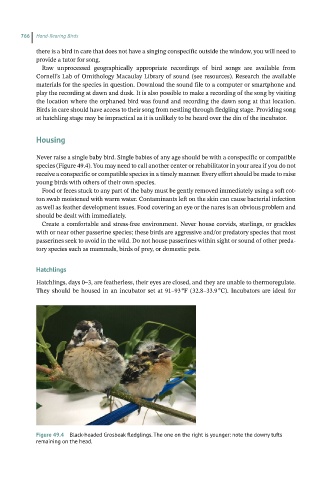Page 763 - Hand rearing birds second
P. 763
766 Hand-Rearing Birds
there is a bird in care that does not have a singing conspecific outside the window, you will need to
provide a tutor for song.
Raw unprocessed geographically appropriate recordings of bird songs are available from
Cornell’s Lab of Ornithology Macaulay Library of sound (see resources). Research the available
materials for the species in question. Download the sound file to a computer or smartphone and
play the recording at dawn and dusk. It is also possible to make a recording of the song by visiting
the location where the orphaned bird was found and recording the dawn song at that location.
Birds in care should have access to their song from nestling through fledgling stage. Providing song
at hatchling stage may be impractical as it is unlikely to be heard over the din of the incubator.
Housing
Never raise a single baby bird. Single babies of any age should be with a conspecific or compatible
species (Figure 49.4). You may need to call another center or rehabilitator in your area if you do not
receive a conspecific or compatible species in a timely manner. Every effort should be made to raise
young birds with others of their own species.
Food or feces stuck to any part of the baby must be gently removed immediately using a soft cot-
ton swab moistened with warm water. Contaminants left on the skin can cause bacterial infection
as well as feather development issues. Food covering an eye or the nares is an obvious problem and
should be dealt with immediately.
Create a comfortable and stress‐free environment. Never house corvids, starlings, or grackles
with or near other passerine species; these birds are aggressive and/or predatory species that most
passerines seek to avoid in the wild. Do not house passerines within sight or sound of other preda-
tory species such as mammals, birds of prey, or domestic pets.
Hatchlings
Hatchlings, days 0–3, are featherless, their eyes are closed, and they are unable to thermoregulate.
They should be housed in an incubator set at 91–93 °F (32.8–33.9 °C). Incubators are ideal for
Figure49.4 Black-headed Grosbeak fledglings. The one on the right is younger: note the downy tufts
remaining on the head.

